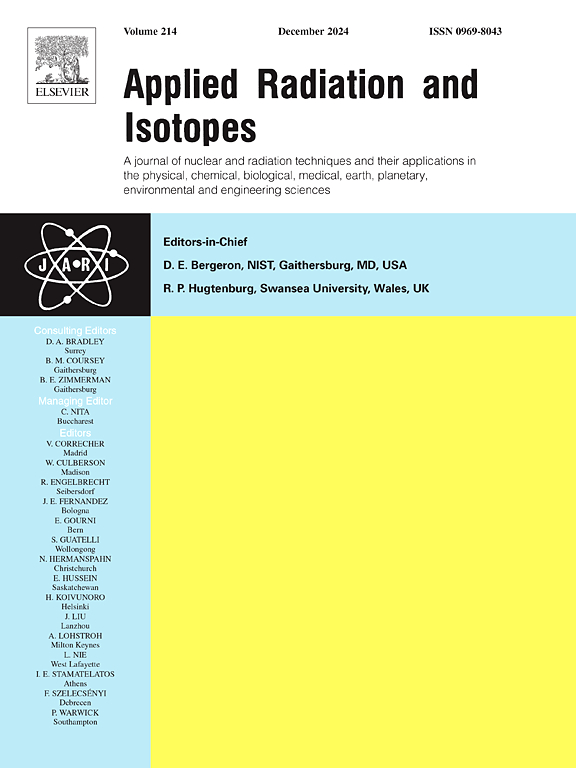Combining 3D printing with OSL dosimeters for extremity monitoring according to ICRU 95 operational quantity
IF 1.6
3区 工程技术
Q3 CHEMISTRY, INORGANIC & NUCLEAR
引用次数: 0
Abstract
The International Commission on Radiation Units and Measurements (ICRU) has recently proposed on its Report 95 a new set of operational quantities for personal and area monitoring. The definition of such quantities is then greatly simplified by adopting the same phantoms already in use to calculate Protection quantities. However, the existing conversion coefficients between these kerma and the operational quantities changes, causing current personal dosimeters to be directly affected as well. Therefore, it is needed for dosimeters to evolve in order to handle changes in their energy dependence response, which often requires re-evaluations or even re-designing holders from sketch. In this scenario, the present paper aims to demonstrate the viability of combining 3D printing through stereolithography (SLA) technique with optically stimulated (OSL) technology of beryllium-oxide (BeO) commercial crystals in manufacturing a dosimeter holder to be used in wrist-type dosimeters for photons. Such dosimeter holder must be able to fulfil the current international criteria even for the new operational quantity proposed by ICRU 95. After being created and properly calibrated, the holder underwent energetic and angular assessment tests. The results showed that the badge performed within a relative response range of approximately . These tests were conducted within an energy range of 23-662 keV and angles ranging from 0°to 60°, as outlined in IEC 62387:2020. The dosimeter demonstrated a satisfactory performance under the specified conditions set by the IEC standard.
结合3D打印与OSL剂量仪,根据ICRU 95操作量进行肢体监测
国际辐射单位与测量委员会(ICRU)最近在其第 95 号报告中提出了一套新的个人和区域监测操作量。通过采用已用于计算防护量的相同模型,这些量的定义得到了极大的简化。然而,这些效应量与操作量之间的现有转换系数发生了变化,导致目前的个人剂量计也受到直接影响。因此,剂量计需要不断发展,以应对其能量依赖性响应的变化,这往往需要重新评估,甚至从草图开始重新设计支架。在这种情况下,本文旨在证明通过立体光刻(SLA)技术将三维打印与氧化铍(BeO)商用晶体的光激发(OSL)技术相结合,制造出用于光子腕式剂量计的剂量计支架的可行性。这种剂量计支架必须能够满足现行的国际标准,甚至是国际辐射防护委员会 95 提出的新操作量标准。在制作和适当校准之后,腕带支架接受了能量和角度评估测试。结果显示,徽章的相对响应范围约为±20%。根据 IEC 62387:2020 的规定,这些测试的能量范围为 23-662 千伏安,角度范围为 0° 至 60°。在 IEC 标准规定的条件下,剂量计的性能令人满意。
本文章由计算机程序翻译,如有差异,请以英文原文为准。
求助全文
约1分钟内获得全文
求助全文
来源期刊

Applied Radiation and Isotopes
工程技术-核科学技术
CiteScore
3.00
自引率
12.50%
发文量
406
审稿时长
13.5 months
期刊介绍:
Applied Radiation and Isotopes provides a high quality medium for the publication of substantial, original and scientific and technological papers on the development and peaceful application of nuclear, radiation and radionuclide techniques in chemistry, physics, biochemistry, biology, medicine, security, engineering and in the earth, planetary and environmental sciences, all including dosimetry. Nuclear techniques are defined in the broadest sense and both experimental and theoretical papers are welcome. They include the development and use of α- and β-particles, X-rays and γ-rays, neutrons and other nuclear particles and radiations from all sources, including radionuclides, synchrotron sources, cyclotrons and reactors and from the natural environment.
The journal aims to publish papers with significance to an international audience, containing substantial novelty and scientific impact. The Editors reserve the rights to reject, with or without external review, papers that do not meet these criteria.
Papers dealing with radiation processing, i.e., where radiation is used to bring about a biological, chemical or physical change in a material, should be directed to our sister journal Radiation Physics and Chemistry.
 求助内容:
求助内容: 应助结果提醒方式:
应助结果提醒方式:


